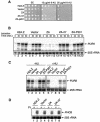H2A.Z has a function reminiscent of an activator required for preferential binding to intergenic DNA
- PMID: 12941702
- PMCID: PMC202369
- DOI: 10.1093/emboj/cdg427
H2A.Z has a function reminiscent of an activator required for preferential binding to intergenic DNA
Abstract
H2A.Z has been shown to regulate transcription in yeast, and that function resides in its C-terminal region as the reciprocal portion of H2A cannot substitute for the latter. We show that fusion of a transcriptional activating region to the C-terminal region of H2A, which is substituted for that of H2A.Z, can allow the chimera to fulfil the special role of H2A.Z in positive gene regulation, as well as complement growth deficiencies of htz1delta cells. We further show that the 'transcription' function of H2A.Z is linked to its ability to preferentially localize to certain intergenic DNA regions. Our results suggest that H2A.Z modulates functional interactions with transcription regulatory components, and thus increases its localization to promoters where it helps poise chromatin for gene activation.
Figures







References
-
- Ahmad K. and Henikoff,S. (2002) The histone variant H3.3 marks active chromatin by replication-independent nucleosome assembly. Mol. Cell, 9, 1191–1200. - PubMed
-
- Allen J.B., Zhou,Z., Siede,W., Fried,E.C. and Elledge,S.J. (1994) The SAD1/RAD3 protein kinase controls multiple checkpoints and DNA damage-induced transcription in yeast. Genes Dev., 8, 2416–2428. - PubMed
-
- Barberis A. and Gaudreau,L. (1998) Recruitment of the RNA polymerase II holoenzyme and its implications in gene regulation. Biol. Chem., 379, 1397–1405. - PubMed
-
- Bash R. and Lohr,D. (2001) Yeast chromatin structure and regulation of GAL gene expression. Prog. Nucleic Acid Res. Mol. Biol., 65, 197–259. - PubMed
Publication types
MeSH terms
Substances
LinkOut - more resources
Full Text Sources
Molecular Biology Databases

